A wise man once told me that I’d be best served by spending my hard earned shekels buying an expensive optic and putting it on a cheap gun versus buying a cheap optic and putting it on an expensive firearm. I’ve certainly been burned before slapping cheap glass on good guns. But good glass, not just the optics, but also the functionality of the package as a whole, can mean laying out a big chunk of change. The Bushnell DMR 3.5-21 x 50mm is admittedly an expensive scope, but it sure seems worth it when you’re looking downrange . . .
Bushnell pegs the MSRP at $2018.95. Thankfully, real world pricing has that number down below $1200. Keen-eyed readers will remember that Nick reviewed this model back at the end of 2012. A lot has changed since then. The real world price has come down. $1250-$1350 is a much smaller number than the original $2000 that Nick reviewed it at. I think we’ve both learned a lot about optics along the way as well. Oh and Nick’s a smaller sized human. Maybe that has an impact too.
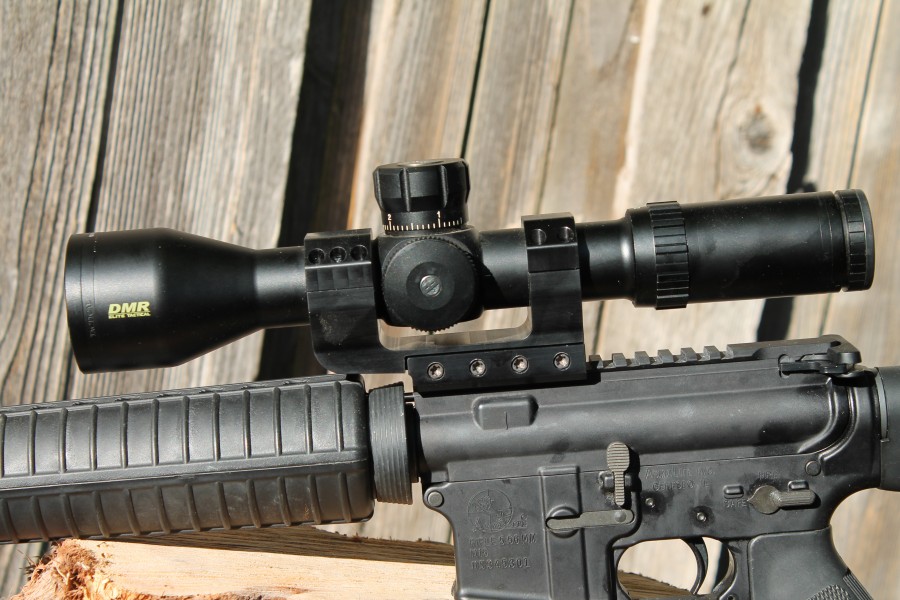
For this test, I had the ability to use this scope for more than static testing at the range. I used it at the Bushnell Brawl earlier this year and had the opportunity to do a bit more than sit at a bench and shoot tracking test targets. That experience really helped me make up on my mind on how good this scope is, especially compared to the scopes that a lot of my fellow Brawl competitors were using.
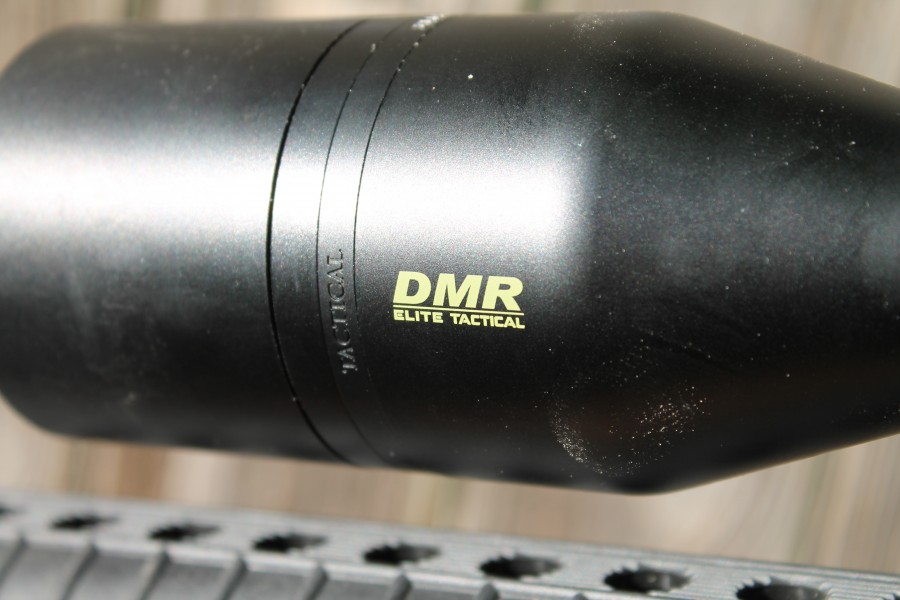
Glass Quality
I had the privilege of looking through the Bushnell and a much more expensive US Optics scope side by side during a practice session for the Brawl, and I will completely concede that the USO scope is clearer, brighter, and generally of a higher quality glass. It also costs double what the DMR costs. For the money, the Bushnell glass is incredibly good. The picture below was taken at 1000 yards on a sunny day with a decent amount of mirage going on. Unfortunately, my camera does not adequately capture the image I could see at these ranges. The real life sight picture is clear and free of distortion.
To test out the extreme end of this quality, I sat out at my ranch during testing of the Baconmaker right at sunset. Legal shooting hours in my part of the world are from thirty minutes before sunrise to thirty minutes after sunset. Some evenings, big groups of whitetail will gather in a field we have. Set up on one side of it, I have unrestricted views out to 350 yards, and right up until the thirty minute mark, I was able to make out individual deer bodies out to the furthest range available at full magnification. Scoping a bit closer, say 250 yards or so, and I was clearly able to make out heads, ears, and jaws giving me the confidence to use this scope for some longer shots right up until the limit of legal daylight. Again, this is fantastic glass that works at all times of day.

Reticle
The HDMR is a first focal plane scope meaning that measurements using the reticle are the same size regardless of magnification. Like most Americans, I grew up using a second focal plane scope, but I’ve grown quite fond of the FFP scopes over the last few years. If your usage of a scope includes zeroing it at 200 yards, and never touching an adjustment again, either system will work equally well for you. However, if your intended usage is to zero it at a distance, and then make a lot of changes for elevation with the turrets, hold for different windages, and/or do some crude range estimation with the reticle, a move to first focal will likely benefit you. With a first focal plane scope, you’ll be able to use the reticle at all magnifications instead of just at the highest level.
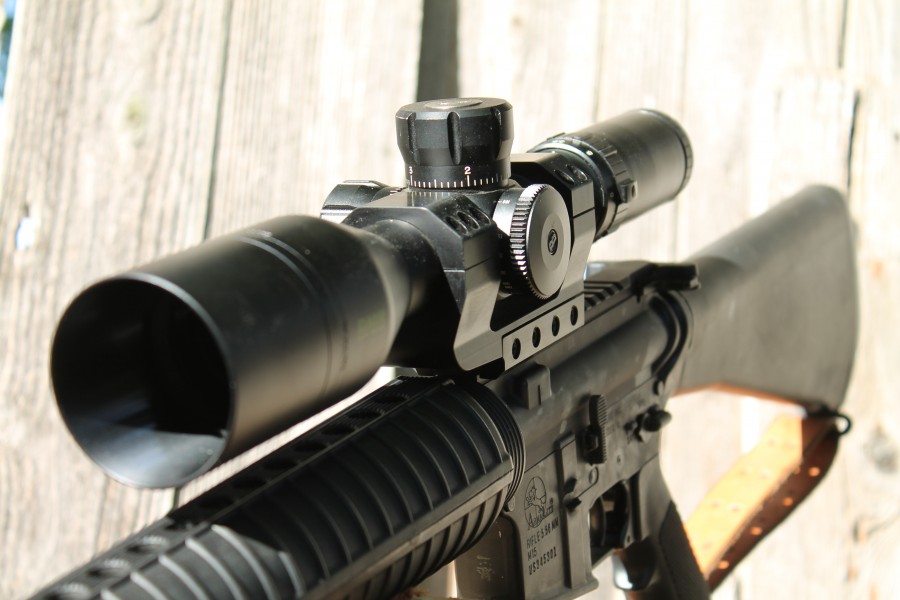
The DMR G2 Reticle is not a fancy reticle. Reticles are a funny thing. There’s a lot of options out there and everyone seems to have a personal opinion. Realistically, that boils down to how you like to shoot your gun at longer ranges. I prefer to dial the elevation and hold for the wind. I’ve met guys who hold for both under a certain range, but will start to dial for elevation past 500 yards or so. Still others like to dial for elevation, and dial windage for the lowest wind value (so confusing to me). All this to say that no one reticle is perfect for everyone.
The G2 sports a traditional crosshair with mil hashes at every half mil along the way. On the horizontal line, whole numbers are the tall hash mark and half numbers are the short hash. At some point, someone did a detailed analysis of the reticle and posted it for the world here. Many thanks to PhotoBucket user tykempster for the work. In practical shooting situations, eight mils of windage holds gets me up to a 38 mph wind hold at 1000 yards using the .260 Remington I borrowed for the Bushnell Brawl. I would never actually take a shot at that distance in that wind, but it is nice to know that I have that much room to work with.
The vertical crosshair is where the compromise between the dial for elevation and hold for elevation guys happens. It is out of frame in the picture I took, but the vertical crosshair goes all the way to 10 mils. If I were a hold for everything shooter, using that same Remington .260 example above, with a 100 yard zero, my dope chart for that reticle would look like the following.
| Distance | .25 mil | .5 mil | |
| 1 mil | 285 yards | 5 mph | |
| 2 mil | 410 yards | 7 mph | |
| 3 mil | 525 yards | 5 mph | |
| 4 mil | 625 yards | 4 mph | 9 mph |
I think that the G2 is a fair compromise for both. If you’re a dedicated hold for everything shooter, but your shooting is mostly in calm winds, the G2 will work fine. If you hold everything and you shoot where the flags stand straight out, you might be better served by a different type of reticle. I shot out to 1000 yards using this reticle and what my ballistic calculator told me to hold, and what I held with the scope always seemed to match up pretty perfectly. As long as I was calling the wind correctly, I was good to go.
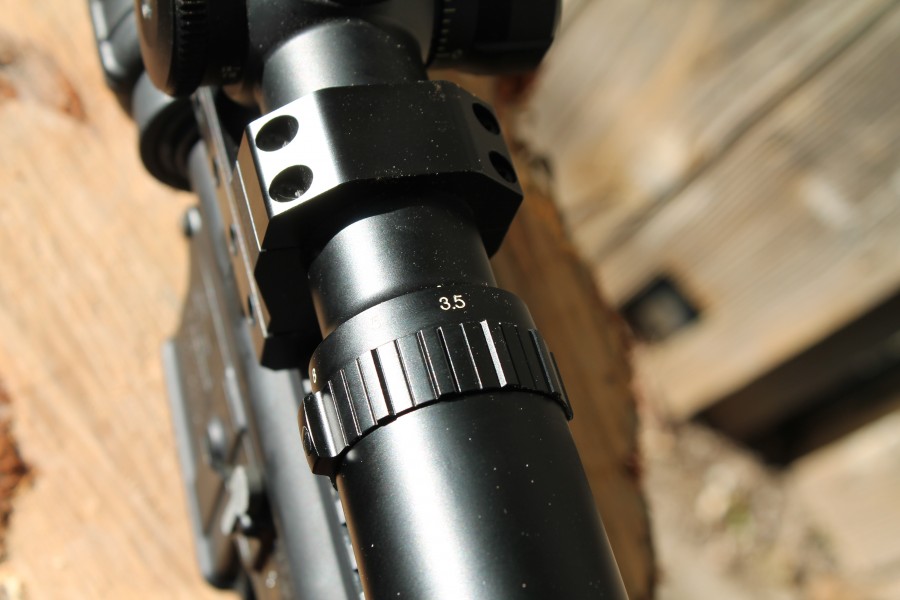
A last note on the reticle. Some shooters use their reticle for range estimation. When I went to the Gunwerks shooting school many years ago, they explained that using a reticle was probably fine out to about 500 yards or so, but after that, the variation in animal body sizes, and the coarseness with which the human eye can pick up detail meant that past that distance, you could induce some pretty serious errors. Since most of my shooting is on game animals that I want to kill humanely and effectively, I’m not comfortable using a reticle for range estimation and would prefer to use a laser range finder backed by real world results shooting at those distances. That said, I found the subtensions advertised to be very usable assuming I knew the size of the target out to roughly 500 yards. In fact, I have a spot at the ranch that allows me to glass the neighbor’s front gate which I’ve measured at 11 feet 8 inches. Using the G2 reticle, I was able to come with a distance calculation of 1296 yards. DaftLogic’s Google Maps Distance Calculator shows that distance to be 1186 yards. In my book, a variation of 110 yards at that distance is about as good as can be expected.
For me, the G2 was about the most perfect reticle I’ve ever gotten to use. It was uncluttered, extraordinarily functional, and very accurate for my needs.
Turrets
The DMR has fully adjustable turrets that lock down very solidly when you need to ensure that errant bumps don’t knock things loose. I found them to be functional, but compared to other scopes on the market, not nearly as elegant as what the rest of the world brings. That’s not a knock on Bushnell’s turret system because it is built like a tank and provides very clear reference on whether your turrets are locked or not. The problem comes when you need to be quick on an adjustment. There’s a lot of wasted movement popping the turret up, making the adjustment, and then popping it back down vs. just reaching up and twisting the turret to the desired mark. It won’t matter to most users, but in competitions like the Bushnell Brawl, that sort of fumbling can cost precious seconds.
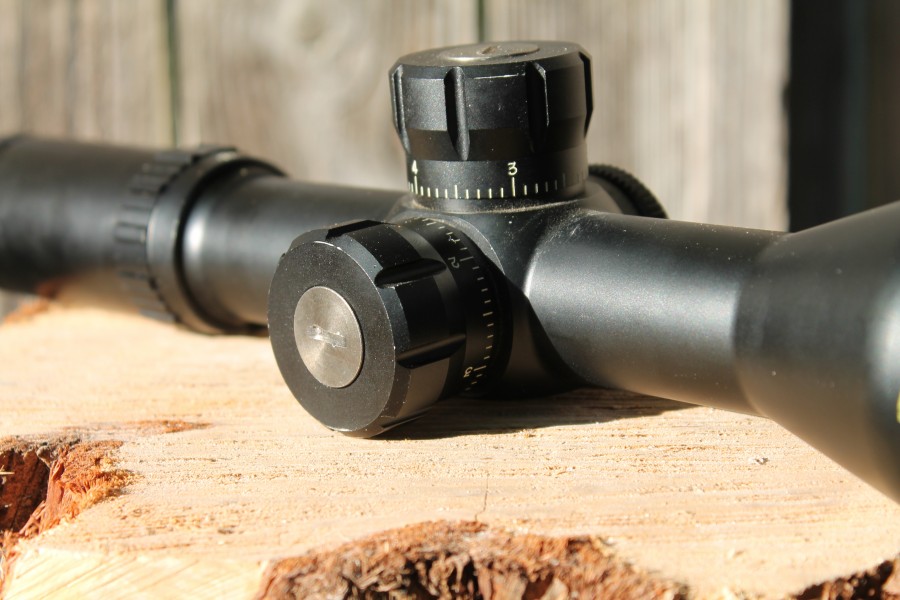
The other nagging little issue is that the DMR doesn’t include a zero stop. A zero stop allows you to set a stop limiting further travel past a certain point, usually your 100 yard zero. This allows you to return your elevation turret to zero by feel alone, or to ensure that your turret is zeroed before dialing elevation by feel alone. Again, the number of users who truly “need” this feature is limited, but it is certainly a “nice to have” on a scope that costs more than a grand.
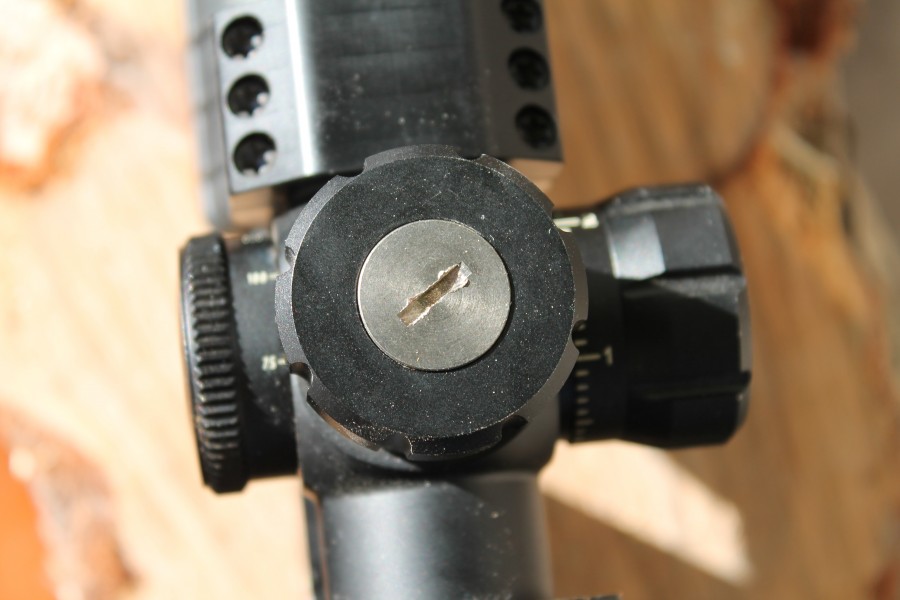
Otherwise, the turrets themselves are pretty perfect. There’s five mils of travel per revolution for each turret which means that a great deal of distance is within one turret revolution. For one of those 140 gr. A-Max pills out of a 6.5 Creedmoor I’m currently testing, five mils of elevation will get me out to 675 yards. 1000 yards is almost another full revolution after that. Once zeroed, you can loosen the screw in the top of the turret, move them to the zero hash mark and screw the screw back down. This provides a nice visual reference for where you are in the adjustment spectrum.
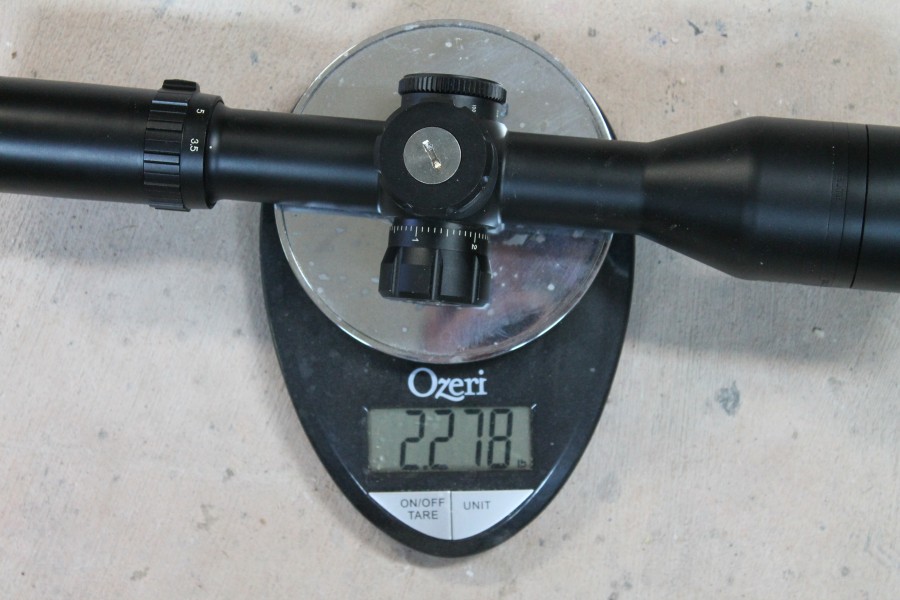
Weight
There’s no getting around it. The DMR weighs a lot. This is not the lightweight scope you’re after. Once you slap it in a suitably robust mount, you’ll be tipping the scales at two and a half pounds of optics and mount. On a long range bolt gun, it kind of fades into the background noise of schlepping around a four foot long, thirteen pound gun, but on a small carbine AR style gun (why?!?), it is enough weight to throw off the balance of the gun slightly making it feel very top heavy. This is not the intended use case for this optic, so that advice probably only applies to gun writers who are testing light weight carbines for accuracy.
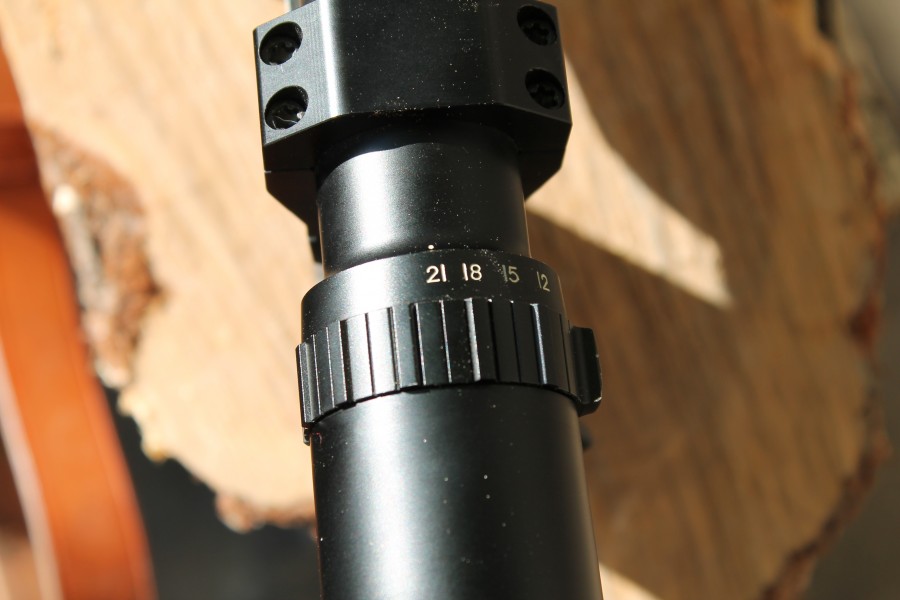
Controls
Aside from the turrets, the only other adjustments on the DMR are the eyepiece focus, the power selector, and the parallax adjustment. The power selector works just fine for moving your way through all those power settings, but it does get progressively “faster” as you near the upper end of the spectrum. As you can see in the photo above, 21X and 18X are very close neighbors while 3X is about 180 degrees away. Either way, the ring is easy enough to get a purchase on even while wearing gloves, and moves freely enough to not require a grunt, but not so free that it shoots loose.
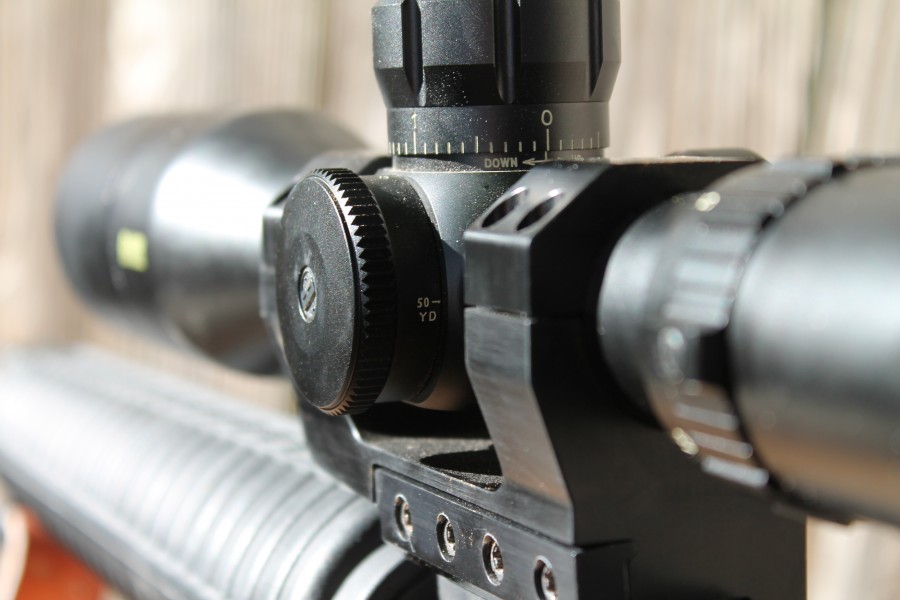
The parallax adjustment is marked from 50 yards to infinity across ~180 degrees of adjustment but I found that the marked distances rarely mated up with actual distance to target. Otherwise, it does a fine job of removing parallax from the equation. Finally, the focus on the eyepiece was perfect out of the box so I didn’t feel a need to do anything but spin it one way and the other to check that it functions (it does).
Normally, I’d post a photo of a piece of graph paper showing perfect little groups at various equal distances so you could see how square this system is. I might update this review later to show that, but I don’t feel particularly compelled to burn the ammo doing that since I already know that it will be squared and perfect.
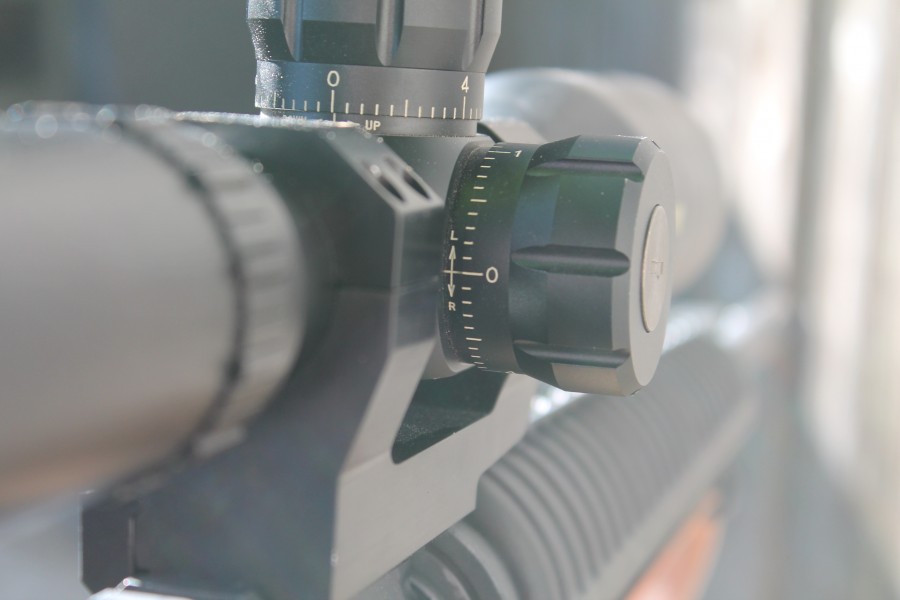
I’ve used this scope across three guns at distances ranging from 25 yards to 1000 over the last five months and without fail, the elevation knob has tracked perfectly. One of the stages at the Bushnell Brawl was three sets of five shots at targets at 700, 800, and 1000 yards. I dialed for each distance and registered hits on very small targets when I did my part to combat the wind. After that stage, I had complete confidence in the turrets, the reticle, and my ballistic calculator.
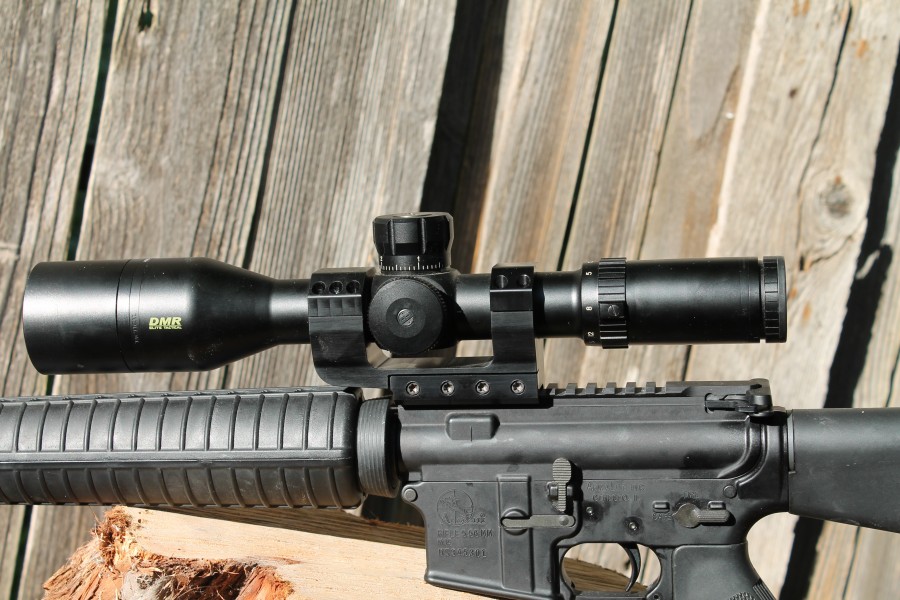
Specifications: Bushnell Elite Tactical DMR 3.5-21X50 mm
- Finish: Matte
- Power x Obj. Lens: 3.5-21x, 50mm
- Reticle: G2 or Mil-Dot (G2 as tested)
- Lens Coating: Fully Multi-Coated & Ultra Wide Band Coating
- RainGuard HD: Yes
- Tube Diameter: 34mm
- Parallax Adjustment: Side
- Field of View (3.5X):
- 25.3 ft @ 100 yds
- 8.4 m @ 100 m
- Field of View (21X):
- 5.1 ft @ 100 yds
- 1.7 m @ 100 m
- Weight: 32.5 oz / 920 grams (36.5 oz as tested)
- Length: 13.2 in /335 mm
- Eye Relief: 3.75 in / 95 mm
- Exit Pupil: 10.4 mm @ 3.5x / 2.4 m @ 21x
- Click Value: .1 Mil
- Adj Range: 29 Mils
- Focal Plane: First
- MSRP: $2018.95
- Street Price: $1249
Ratings (out of five stars):
Glass Quality * * * *
There are $3000 scopes with glass that is marginally more clear, but at this price range, I think you’d be hard pressed to find better glass.
Reticle * * * * *
I can’t find enough good things to say about the G2 reticle. I found it to be enormously useful off the bench and in practical shooting scenarios. Just enough enough to help you get the job done without so much info that it gets cluttered and difficult to use.
Turrets * * * *
They work really well and are built like a tank. Unfortunately, they aren’t the fastest adjusting turret I’ve ever used and they lack a zero stop stop so the DMR loses one star
Overall Rating * * * *
What it lacks in zero stop and fast turrets it makes up for in precision and clear glass. The DMR is not the sexiest, sleekest, or lightest scope on the market, but it is enormously useful in real world shooting scenarios. It has become my default testing scope for new rifles and new ammo as it provides enough magnification to get me out to longer distances and turrets that I know are supremely accurate right out of the box. For the real world money ($1250), I think this is a great step into the world of high end optics for those looking to make the jump.

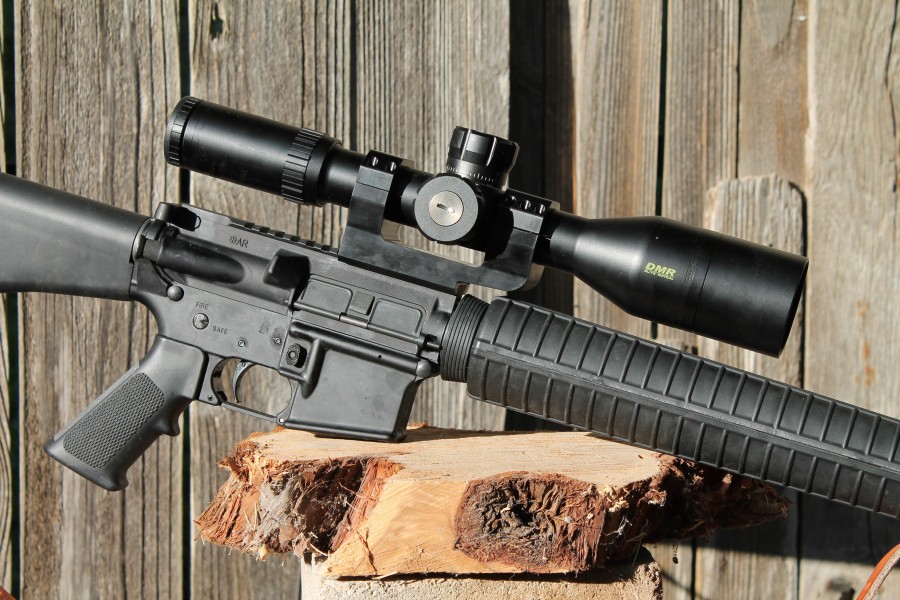
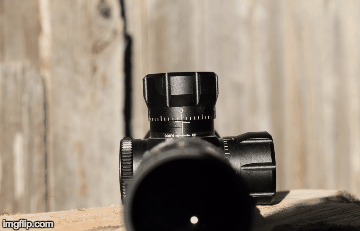
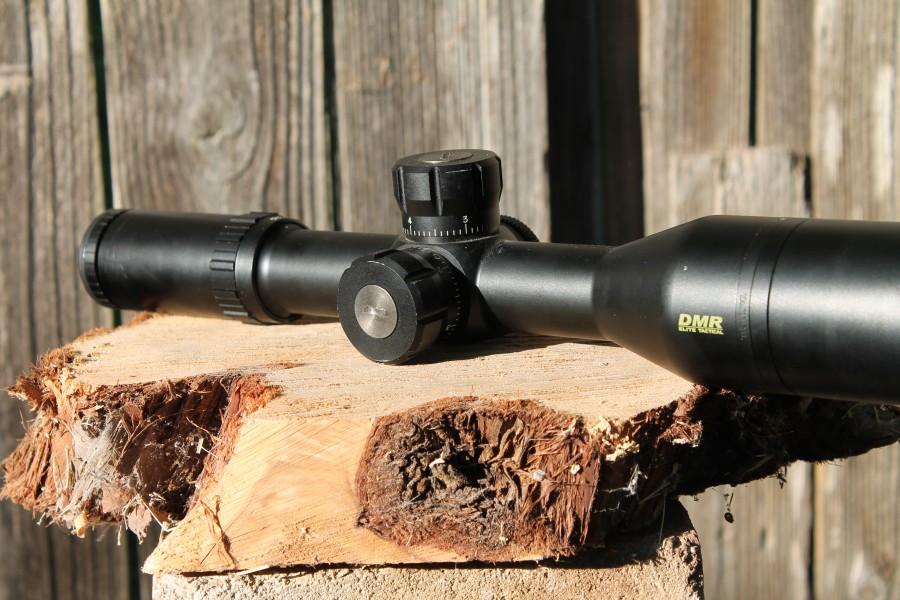
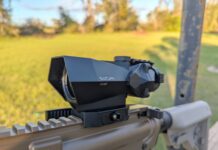


Quick hypothetical, if price was no object, what glass would you put on a tricked out .308 SASS with a 24″ barrel?
I’ve never met a USO owner who sold their scope for a Leupold or Nightforce or Bushnell. So either one of those two
http://www.usoptics.com/optics/er-25.html
http://www.usoptics.com/optics/lr-17.html
Tyler isn’t off base with the USO, but personally for the stick you are asking about I’d go with a Nightforce F1 3-15x. If you really want a little more power and don’t mind the extra bulk and weight, Schmidt and Bender PMII 3-20x.
I have shot basically that exact setup, was hunting at a friends place and he loaned me his 20″ Remington 5r wearing a USO ER-25 and a surefire socom 7.62-rc. That was one heavy fvcker of a gun to haul around in the field. I guess it depends on what you want to use it for.
The owner of that rifle commented that while the USO is absolutely worth every penny as far as optical quality, but it is significantly heavier and the user interface is not very intuitive and setting up initial zero requires some disassembly if you want the elevation and windage to read “0” when zeroed, he decided it wasn’t worth it and just stuck some electrical tape with an arrow on top of the knob so that it would be parallel to the scope body and pointing forward when at his 100yd zero. Said he would buy a night force if he could do it all over again only for the simpler UI and setup NOT because it was better glass than the USO.
So again, depends on what you want, and like Tyler said, this guy definitely isn’t about to sell his USO.
The gun was built as a bet that it is possible to repeatedly ring a 12″ plate at 1200 yards with a .308 I’ve got the hardware and load more or less tuned, but I’ve found that I lack the glass to accurately engage something that size at that distance.
I love my 308’s, I love proving people wrong when you can shoot then at distance especially. What load are you working on? If you don’t mind me being nosy.
I have a 26″ 308 Remington VLS that I have been playing with Alliant RE17 and the Berger 185gr “Juggernaut” aka Tactical LRBT Hybrid. It’s a little light for the RE17 but I am expecting 2650-2700fps, which will do some beautiful things with that Litz True G7 BC of .283 for these pills. 🙂
Reloading the has been on the back burner for me, but I picked this rifle up last year and it has gotten me excited about it again. I am pushing 2815fps with factory loads Nosler Trophy grade shooting 165grain ballistic tips.
For what it’s worth I have a “lowly” Vortex 4-16x HS-LR optic on that gun. Really good value.
How does this compare with Vortex?
Much better optical quality than the Vortex PST line not quite as good as the Razor HD
I always tell my clients the rule of thumb is not to spend more on your optics than you did on your rifle. Rifles tend to hold their value better. There are some excellent mid-priced brands out there, and then there are the very expensive scopes that are noted for their durability, optical quality, and/or special features. There is no right choice, but there is a best choice for you based upon your perceived needs and desires. The best advice I can give them is to avoid the cheap chunk and read the warranty carefully. Online reviews can help you choose, but they can’t make the choice for you.
Just hope you never have to send it in for repairs. I have a HDMR that I’ve sent in 4 or 5 times now. 3 of those times were for repair caused issues such as greasy fingerprints on the inside of the objective lens.
For 308 long range u cant beat the price of hornadys 208 gr amax, if u can get enough velocity without signs of pressure. I bought this scope off amazon refurbished for 1100, then saw milehigh shooters had the 4.5×30 bushnell with zerostop for 1200, so i sent the smaller scope back and got the big boy with all the whistles. If i was anyone looking at this scope watch for a sale and get the bushnell extreme version with zerostop as they can be found for near comparable prices….its heavy as all get out but the flass is really really good for 1k, and u get 34mm, the g2 reticle, which i think is the best reticle out there for long range shooting, and a zero stop. The only real downside to these scopes is they have much less travel than the nf and uso and s&b, so u will probably need to buy a mount with built in moa if u wanna shoot extreme long range….
I have a similar scope – but the FDE version with a zero stop – that’s on a LaRue QD LT-111. It’s curently doing double duty on my Savage 110 BA .338 Lapua and a 300 BLK AR build.
I haven’t had the chance to do long range with either set up. I sent my Bushnell in after it fogged up during and extremely foggy whitetail deer hunt in WI. I still got my buck, though. He was a decent sized 6 pointer, but the shot was only at about 40 yards.
I’m fully aware that it’s a lot of scope at short range, but I was eager to check it out. I don’t mind hunting with heavy guns (unless I’m in the mountains at altitude).
Anyways, my short range experience with the scope and its characteristics have been similar. However, I did have to send mine in for repair. Post repair performance seems good, and it holds zero just fine on my .338.
Good review. In my opinion, this is a good entry level premium scope appropriate for long, medium, and short(ish) range. The reticle is pretty thin at 3.5x (FFP scopes have small reticles at low mag and the reticle size increases at the top end). Of course there are much better options at close / intermediate range, or for lighr weight.
I have this Bushnell on my FN TSR .223 bolt gun and a US Optics on my Steyr SSG 69 in .308, but in the past I’ve used the Bushy on the Steyr, too. Both are way, way too heavy for hunting, but when it comes to shooting off a bipod, given the price differential, I’d be hard pressed to have to pick one or the other.
Unless something changed, Nightforce scopes, with the exception of a handful of models, are all second focal plane. As of my last scope buy, Nightforce didn’t make any first focal plane models, and I didn’t even consider them as an option.
I’m accepting donations of high grade optics. USO, Nightforce, etc. All these sound good. If you would like to donate one to me – just let me know.
跟着中国互联网的突起,良多美国服务器纷纭进驻中国, 信任有许 海外美国高防云服务器,vps的剖析抉择 多童鞋在取舍美国服务器上费尽了脑筋,到底什么样的美国服务器才是性价比最高的呢,小编就此逐一 云主机 为大家介绍几点。 ,海外美国高防云服务器,vps的剖析抉择; 1、 硬件客户体验是最优 因为久途数据是一个年青的美国主机服务商,目前所有服务器的服务年限都较短,家喻户晓服务器在3年以内故障率在3%以下,然而3年以上故障率就会回升至5%以上。比起一些资深的美国主机服务商,久途数据的硬件客户休会是最优的。 海外美国高防云服务器,vps的分析选择 2、 优良的产品参数配置 每当新的硬件宣布时,久途数据的技巧职员们
跟着中国互联网的突起,许多美国服务器纷纭进驻中 海外美国高防云服务器,vps的剖析抉择 国, 信任有良多童鞋在取舍美国服务器上费尽了脑筋,到底什么样的美国服务器才是性价比最高的呢,小编就 海外美国高防云服务器,vps的剖析抉择 此逐一为大家介绍几点。 ,海外美国高防云服务器,vps的剖析抉择; 1、 硬件客户体验是最优 因为久途数据是一个年青的美国主机服务商,目前所有服务器的服务年限都较短,家喻户晓服务器在3年以内故障率在3%以下,然而3年以上故障率就会回升至5%以上。比起一些资深的美国主机服务商,久途数据的硬件客户休会是最优的。 2、 优良的产品参数配置 每当新的硬件宣布时,久途数据的技术职员 HS服务器 们
Comments are closed.